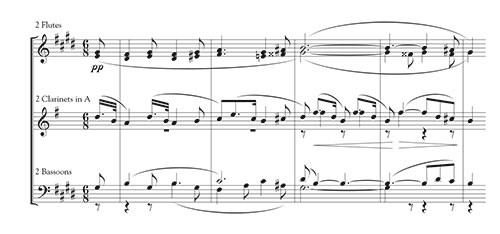Those contemplating a second flute position in an orchestra may confront some common myths of dubious origin about the audition. There is the somewhat harmful Dry Toast notion; that one should sound a bit bland or uninteresting, like the taste of dry toast, in order to win. In this case the audition committee may think that a player may stand out too much if they demonstrate the manner of a principal. Heaven forbid, they might divert attention away from the principal flute, who more often than not occupies a chair on said committee.
Another characterization of second flute is that of the Show Pony. From the candidate’s point of view, playing second flute is a sort of special category, requiring perhaps an unattainable and unusual set of skills somehow beyond the scope of normal chamber music practices. For the candidate, if first chair wind playing is like riding a race horse, playing second flute must be something more precious, like riding a show pony.
Both of these notions are almost entirely illusions, born of fears of both committee and candidate, and confusion between roles in the orchestra and the skills needed to execute them. Remember that ultimately the audition is primarily about proving your skills, and playing in an orchestra is about using those skills in the most flexible manner.
Boring Ninja
It is understandable to think that you may have to play less interestingly for a section position. After all, second flutists do spend much time working in the trenches, trying to balance, or imitate the principal and blend. It can be tricky, inglorious duty. There are not loads of solos. Additionally, auditions for second chair seem heavy on ensemble passages and a bit scant on solo licks. Fair enough. Does that mean in order to win you must come off as some kind of Ninja player with a tiny personality? That seems strange, and difficult, especially for a wind position. That would be very different indeed than auditioning for principal.
This may be only the tip of the iceberg in terms of questions you have on this topic. Below are more questions that may have crossed your mind and my thoughts on the answers.
1. How do I know what the orchestra is looking for in the audition?
You don’t. Many committees do not know what they are looking for either.
2. What kind of orchestra would want boring players anyway?
A boring orchestra or boring committee. Most orchestras really do want exciting players, but boring orchestras do exist. You can research that.
3. If they want a player with little or no solo personality why do they ask for a concerto and solo excerpts?
Because there are solo passages for second flute. Besides, the conductor might love your playing. You could play a concerto sometime.
4. But then isn’t the audition just about the same as a principal flute audition?
Yes.
5. But it is not a principal audition. Does the committee actually want the solo passages to sound more boring than a principal would sound?
That would be weird and unmusical. It could happen. Some orchestras do sound sort of weird and unmusical. More likely, they might want you to sound somewhat like the principal. Again, do some research into the orchestra.
6. Should I change my approach to match the way the principal sounds?
If it feels natural enough, you could try. Imitating the principal can be important for a second flute, but you also might get it wrong. Think ahead. If you get the position, do you want to play that way every day? It may be better to just be yourself and see where the chips fall.
7. Why ask for so many different ensemble passages?
Because not all ensemble passages require the same approach. Some require blending, some equal voicing, some solo aspects, and some all of the above.
After thinking about all of this, you may reach the conclusion that I have. There is no real difference between auditioning for principal or second. The Boring Ninja will usually not succeed, for both artistic reasons in the audition and practical reasons in the section. Jennifer Nitchman, second flutist of the St. Louis Symphony, says skills like flexibility and imitation are not only required, they are interesting: “Ideally, you are auditioning for the job of being able to sound like the principal. This includes playing in unison, playing an equal role in duets, trading melody lines, and playing fully independent solos, often fulfilling many of these roles in rapid succession. How could a boring player do that?”
The bottom line is that the rules for all auditions are the same: demonstrate that you have achieved an appropriate, genuine, interesting, consistent yet flexible, and cohesive mastery of the material. If the committee is able to define what they are looking for, it helps. However, you may or may not ultimately be a great match with the section, which leads to the next point.
No Show Pony
In these nearly identical solos from Ravel’s Mother Goose, depicting a mournful procession for Sleeping Beauty, both principal and second flute lead as soloist in the orchestra. The second flute actually begins the piece and takes the primary role. The principal plays the same solo later in the movement, at a different dynamic. Both solos require the same skills: the personality and confidence of a leader, appropriately magical, yet somber characterization and good fundamentals.
Ravel: Mother Goose Pavane de la Belle au bois dormant, Flute 2, measures 1-4
.jpg)
Ravel: Mother Goose Pavane de la Belle au bois dormant, Flute 1, measures 13-16.
.jpg)
Next, look at Brahms’ Symphony No. 4 in E Minor, Op. 98, second movement, measures 8-13. This Wagnerian and even more solemn processional passage from Brahms’ Fourth Symphony, featuring flutes and other winds in accompaniment to the clarinet solo, requires exactly the same skills from principal and second. Both must adjust to the clarinet, with scant vibrato, and the dynamic as soft as possible without pitch sagging. The second flute emerges in measure 12. Both excerpts have the same requirements for principal and second flutes. So, playing principal is the same as playing second flute in terms of skills. There is no Show Pony for this position. It just takes good chamber music skills and appropriate playing in the context of the music.
Brahms’ Symphony No. 4 in E Minor, Op. 98, second movement

Also, contrary to the common prejudice, not only the second, but the principal should be willing to subordinate their role in the music. Erich Leinsdorf, in his iconic tome, The Composer’s Advocate: A Radical Orthodoxy for Musicians says, “Music is made of a fabric that combines [both] leading and accompanying voices…If a soloist’s ego has swollen beyond control, roles…will never be properly distributed.”
Again, all of this shows that there are no skills required for auditioning for second flute that are not required for principal auditions as well.
More Questions
By this point, you may be feeling entirely frustrated. If the skills are essentially the same for principal and second flute, why do these opinions exist? Because there are real differences between the positions too. In terms of actual orchestral playing, there are frequently different roles for the second and principal flutists. Players in both chairs, while having the same skills, may possess certain aptitudes which make them ideally suited for their roles. So there are general attributes which a committee might be looking for in a second flute although they may not be able to clearly identify them until the ensemble round.
Roles and Aptitudes
In the most general sense, differences between principal and second can be summed up this way: When playing in an ensemble, the player who is more inclined towards playing second flute will not show an overt need to lead, and more often than not, will comfortably fit into the texture. Also, they will frequently show, in tonal characteristics and aptitude, a natural flexibility of being able to blend and follow, while still being easily able to project the sound and emotion above others when needed.
A player more inclined towards principal playing will tend to show a need to lead and be comfortable with standing out in terms of voicing, projection, emotion, and rhythm, while still being easily able to blend.
Winning Second Auditions
To win any audition, you must have a lot of control over your playing. For a second flute audition, play with the attributes of a principal for the solo rounds. Be yourself. As in any audition, play with taste and care regarding extremes and liberties. Show the committee you are a strong and flexible player, then let them sort the rest out. In the ensemble rounds, where you get to display chamber music skills, play with the attributes of a second.
If solo projection is the hallmark of a principal, then flexibility is the coin of the realm for a second player. Judge your degree of projection, both of tone and emotion, and don’t try to lead unless you believe the score calls for it. When it is your moment to shine, or to lead, go for it.
As for the committee, are these characteristics discoverable in one standard audition? Perhaps, if they know what they want, but these are complex issues. When the audition is successful, the attributes above are usually part of the players’ basic approach towards the music in general, and part of their personalities as well. Both sets of characteristics are of equal value and importance to the music, and both are necessary for success in both the audition and the ensemble.
If you are thinking of taking a second flute audition, but struggling with these ideas, take a moment to ask yourself honestly if your attributes and attitudes are naturally well-suited to the position.
Second Flute, First Love
There is one crucial aspect of the second flute position not yet mentioned. A successful second flutist should enjoy playing second. The chair can be difficult, but rewarding in many ways. Says Nitchman, “Like any job, playing second flute has its frustrations, but with the right perspective, there are many benefits to the position. This role has done some amazing things for my playing. I’ve increased my range of tone color and vibrato, and the intense listening skills required have made chamber music much more fun than it used to be. Also, the joys of a successful musical partnership with your principal flute cannot be overstated. If you find yourself playing second flute, you may be surprised by how much you love it.”
Question your preconceived notions about playing second flute and really try understand the role, both in auditions and in the job. If you do, you will surely discover similar enrichment.






